1962 Jodel DR.1050 Ambassadeur D-EHIE


I bought D-EHIE (my U.S. flight instructor named her 'Heidi' ...) in early March 2000 from Ms. Elfriede Schweiger of Wenzenbach, a little town northeast of Regensburg in Bavaria, Germany. So how did I get to buy a plane and how did I decide on this particular aircraft?
Well, ever since I learned to fly in 1992/1993, I had had hopes of owning my own aircraft someday - which pilot hasn't? At the time, as a student, it was bound to stay a wish due to 'limited' resources and the fact that I did not have a German pilot's licence at the time. These obstacles vanished over time, and after graduation from the University and actually finding a more or less decent paying job, I started saving every penny I could. At first, I did look more casually through ads in magazines and the internet. This changed after I decided for various reasons from one day to the other that flying in a flying club was not for me any more. This left me without a 'magic carpet' right at the start of the flying season in 1999. I managed to get over the year with a visit to my friends in the U.S. where I had the opportunity to do some flying. After my return from this vacation, with the savings account for the plane growing from month to month, I started looking more specifically after planes that would suit my interest, my needs, and (unfortunately), also my bank account and my future monthly allowance for my 'hobby' (it's more ...). The requirements which I decided upon looked as follows:

|
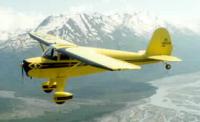
|
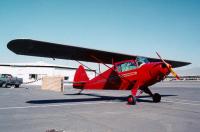
|
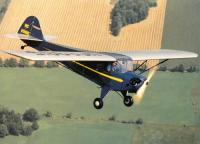
|

|
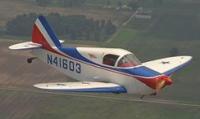
|
Up until a few weeks before I bought 'Heidi', I had settled quite firmly on an aircraft imported from the U.S. My first reason for this approach was my wish to get a classic aircraft like a Cessna 120/140, a Luscombe Silvaire, a Porterfield, a Taylorcraft, an Aeronca Chief, a Culver Cadet or similar -- all low-powered economical to operate, cheap-to-buy and interesting types which are almost non-existent in Europe (Later, during the research for the list of all DR.100 series aircraft ever built, I found out that quite a few of these types do exist in the U.K., but I didn't know that back then ...). I had planned to leave the airplane on the U.S. register for several reasons. The advantages of such a constellation are that I could operate it with my U.S. license (which includes the possibility to do night flying and access to all VFR airspace as 'standard'), the plane doesn't need silly and ugly 30 cm (12 in) high registration numbers, the German noise standards cannot be enforced quite so badly as with German registered planes and I wouldn't have to replace U.S. radio gear with the same equipment but an additional stamp on the back from German authorities, which can be quite expensive. The drawbacks of this scenario are additional annual costs to pay for the maintenance of the trust fund (which is the only legal way for a non-U.S.-citizen to own a U.S.-registered aircraft), the value added tax I would have had to pay plus customs taxes and the fact that only very few mechanics with U.S. licenses operate in Germany which could make maintenance of the aircraft more difficult and/or more expensive. But the decisive point to abandon those thoughts were the ever-raising value of the U.S. currency (and therefore the costs involved with acquisition and the trust fund) and the difficulties and the time necessary to find an aircraft in the U.S., make it ready for and find a shipping company in the U.S. within a timeframe of not more than about five weeks.
After I unwillingly had come to realize that I could no longer afford an airplane imported from the U.S., I didn't know what type of aircraft to look for which would fulfill my requirements mentioned above and which would still be available in Germany. The market in Europe and especially in Germany is so much smaller that not many possibilities do exist. Some of the aircraft I did not look after seriously although they are sometimes relatively cheap to acquire were for example:
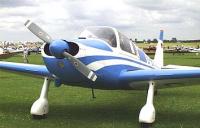
|
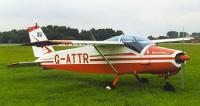
|
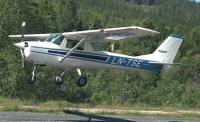
|
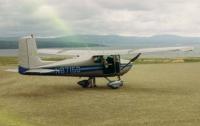
|
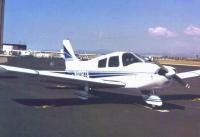
|

|
Essentially, this doesn't leave many types for consideration. After the Jodel web pages of Hans Teijgeler returned online in late January of this year, I started looking at several Jodel models and found them to be quite interesting, especially the 3 to 4-seat DR.100 series and the faster 2-seat D.150 'Mascaret'. Both are powered by the economical and reliable Continental O-200, so operating cost would be as small as is possible with a regular Echo-class aircraft. Later and more powerful Jodels/Robins have more powerful and therefore thirsty engines and also a nosewheel gear, which makes them look not as nice as the older taildragger models in my opinion. Also the car-like cockpit doors and the non-swept vertical tail add a lot to the classic look of the aircraft which I like very much. What I don't like on Jodels/Robins in general comes from my previous experience with DR.400's: the 'strange' nosewheel/tailwheel steering and braking setup, which I consider a lot less easy and convenient to use than the 'regular' Cessna/Piper setup.

In the end, I settled for an aircraft of the Jodel DR.100 series, although the Mascaret is generally faster and has almost twice the range. The reason for this decision was the fact that I liked the possibility to carry a third person on occasion and an ad that appeared in Hans Teigeler's www.jodel.com in February. There a DR.1050 was up for sale, and the pictures and the description looked promising. A personal inspection of the plane revealed no major shortcomings, the engine has still a lot of hours to go and I was able to negotiate an adequate price for the plane. So a deal was struck relatively quick and since early March 2000, I am the proud owner of 'Heidi'. At the moment, the aircraft is still based at Nittenau/Bruck airport northeast of Regensburg, but after a lot of searching I have found a hangar space at Bad Ditzenbach airport (EDPB), where the aircraft will be based starting in May of 2000. I hope that all the paperwork will be settled soon so I can look forward to some interesting flights this summer and thereafter.
Update 10 June 2000: About 2-1/2 months after signing the sales contract, all bureaucratic hurdles have finally been overcome: The registration papers arrived in the mail today. Now I can finally plan on getting my checkout and moving the aircraft from Nittenau/Bruck airfield to its future home at Bad Ditzenbach with about a 2-month delay.
What can be learned from this involuntary delay? First, if you own an aircraft, make sure that you have a last will stating (among other issues, naturally) what will happen to the aircraft in case of your death. This document can prevent a lot of additional trouble, paperwork and cost for the people that would have to sell the aircraft in such a case. Secondly, for a buyer it would be wise to check with the LBA what kind of papers they need to transfer the ownership to him, e. g. which person/persons have to sign the sales contract resp. which person/persons are actually the owners of the aircraft before signing the contract. This could prevent unpleasant surprises (delays, additional expenses) later on. Once the registration papers of the previous owner have been sent to the LBA, the aircraft is effectively grounded until the new ones arrive. So make sure that nothing stands in the way of getting the new papers before you do sent in the old ones.